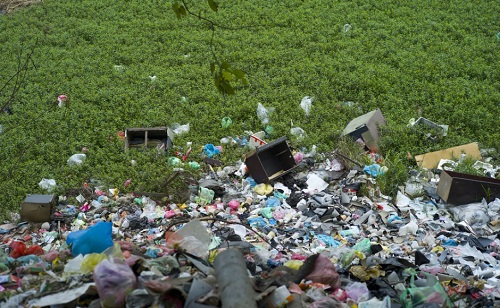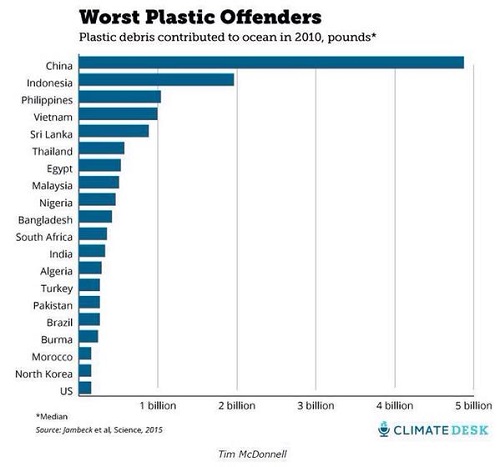5 Asian Countries Produce Majority Of Plastic In World’s Oceans
In the Pacific Ocean, about midway between the west coast of North America and Asia, lies a concentration of mostly plastic waste roughly twice the size of the U.S. state of Texas. Known as the Great Pacific Garbage Patch, this area is formed by the North Pacific Subtropical Gyre, an enormous whirlpool of oceanic currents caused by the Coriolis effect, the phenomenon that makes water swirl. Oceanic gyres, like the Garbage Patch, gather debris both visible and microscopic.
How plastic waste is poisoning our oceans
Some 80 percent of oceanic plastic originates on land, entering via rivers and wind, with the rest coming from ships and oil rigs. Once in the water, the plastic that doesn’t wash up on the world’s beaches or end up in the stomachs of animals, such as sea turtles or sea birds, eventually breaks down.
But plastic doesn’t organically degrade. Instead, it turns into microscopic particles that are often ingested by fish and other marine life, which mistake it for plankton. Zooplankton and phytoplankton occupy a vital part of the food chain that can ultimately end in human consumption. In short, whatever fish eat, people eventually eat too. This means that we not only eat chemicals contained in plastic, but also pollutants in the ocean that the plastic absorbs.
Eight million tons of plastic per year — and growing
While the effects of plastic waste in our oceans has been studied over the past few years, data concerning the total amounts oceanic plastic originating on land has been lacking. New research provides a clearer picture.
From the abstract to “Plastic waste inputs from land into the ocean”, recently published in Science magazine:
“By linking worldwide data on solid waste, population density, and economic status, we estimated the mass of land-based plastic waste entering the ocean. We calculate that 275 million metric tons (MT) of plastic waste was generated in 192 coastal countries in 2010, with 4.8 to 12.7 million MT entering the ocean.”
Most plastic in our oceans comes from China, Indonesia, Philippines, Vietnam, Thailand
Of the circa eight million tons of plastic that reaches the Earth’s oceans on a daily basis, most is coming from five major Asian countries, all of which are developing and experiencing impressive economic growth. Yet all also have infrastructures that are struggling to keep up with their pace of development.
Of the circa eight million tons of plastic that reaches the Earth’s oceans on a daily basis, most is coming from five major Asian countries, all of which are developing and experiencing impressive economic growth.
A recent report by Ocean Conservancy, a non-profit, Washington, DC-based environmental advocacy group, details the sources of plastic waste in our oceans and offers some solutions.
“While all countries with coastal access contribute to the ocean plastics problem, over half of the material leaked into the ocean comes from five rapidly developing countries where production and consumption of plastics is outpacing local waste management capacity – China, Indonesia, Philippines, Vietnam, and Thailand , in order of magnitude.”
—Stemming the Tide: Land-based Strategies for a Plastic-Free Ocean
All five Asian countries are still industrializing and experiencing rapid urbanization, strong factors in the creation of plastic waste. This means that if things continue as they are, the amount of plastic entering our oceans is set to greatly increase.
Yet there is hope. The Ocean Conservancy report outlines several ways these countries can improve waste management while reducing plastic waste and the leakage of that waste into the oceans. It estimates that these steps — detailed in brief in the report’s summary — would reduce plastic pollution by 65 percent in the five countries and reduce the global amount of plastic entering the oceans by 45 percent.
Source: Asian Correspondent


